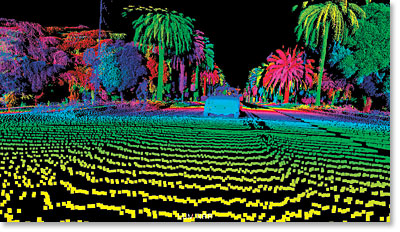Lidar for autonomous cars makes optics and photonics “hot” again
The magic of photonic circuitry. (An SPIE Professional article).
A new generation of lidar companies supplying the self-driving car industry is putting optics and photonics back at the center of the technology world.
Solid-state LiDAR systems are a key enabling technology for self-driving vehicles, 3D mapping, and industrial automation. Early LiDAR systems were too bulky, expensive, and had too many moving parts.
Commercial advancements have made sophisticated mapping, object detection, classification, and tracking possible with small sensors that will become ubiquitous, particularly as they enable autonomous vehicles or "self-driving cars". The magnitude of the market opportunity has been recognized by venture capitalists who have poured investment into this area.
 "Photonics is instrumental in making self-driving cars safe and ubiquitous," says SPIE Fellow Jason Eichenholz, cofounder and CTO of Luminar Technologies, a US-based photonics startup that announced in April it is beginning production of a lidar system with an InGaAs design receiver operating at the 1550nm wavelength.
"Photonics is instrumental in making self-driving cars safe and ubiquitous," says SPIE Fellow Jason Eichenholz, cofounder and CTO of Luminar Technologies, a US-based photonics startup that announced in April it is beginning production of a lidar system with an InGaAs design receiver operating at the 1550nm wavelength.
Luminar is one of the newest players in a fast-growing field of around 80 competitors such as Tesla, Google, and Quanergy Systems.
In 2016, Luminar acquired Eichenholz's company, Open Photonics, an SPIE Corporate Member and frequent sponsor of the SPIE Startup Challenge at Photonics West.

A view of a city street from the Luminar lidar system.
 “In the late ‘90s, optics was king,” says SPIE member Louay Eldada, founder and CEO of Quanergy Systems, one of the leading companies working on the technology for autonomous vehicles. “Now it’s king again, because of lidar, the hottest area of technology.”
“In the late ‘90s, optics was king,” says SPIE member Louay Eldada, founder and CEO of Quanergy Systems, one of the leading companies working on the technology for autonomous vehicles. “Now it’s king again, because of lidar, the hottest area of technology.”
Both entrepreneurs have years of experience commercializing optics and photonics technologies.
While lidar systems have become a familiar sight on early versions of self-driving cars, typically sitting rather bulkily on top of the vehicle roof, a key focus today has been to shrink both the size and cost of the technology.
During a standing-room-only keynote talk at SPIE Defense + Commercial Sensing (DCS) in April, Eldada showed a photograph of a Mercedes coupe featuring two of Quanergy’s solid-state lidar sensors.
"You don't see the ‘lab bench' on the roof of the vehicle," he said. Instead, he held up a small box, the size of two playing cards, containing the core of his product. This is what "hides" behind the grille of the red Mercedes, Eldada told the crowd. That product, which can crunch through half a million data points per second to generate a live view around the vehicle, is Quanergy's "Gen 2" effort. It costs about US$250 in large quantities.
"It's really cheap stuff," he said. "The magic is in the photonic circuitry."

An article in the July 2017 issue of SPIE Professional shows how a new generation of lidar companies supplying the self-driving car industry is putting optics and photonics back at the center of the technology world.
Read the full article about laser technologies in SPIE Professional.



